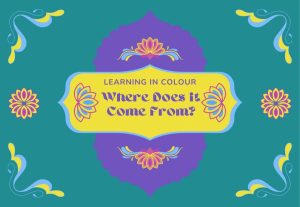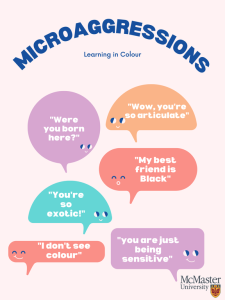8 Where Does It Come From

Racism and discrimination are normalized within our society, meaning that instances of racial trauma and discrimination can happen in a variety of social situations, contexts, interpersonal dynamics, and locations.
Where does it come from?
CONTENT WARNING: Depending on your lived experiences and identities, some of the content on this site may be troubling, uncomfortable, challenging, and, at times, triggering. Engage mindfully and intentionally when embarking on your exploration of Learning in Colour, and connect with resources for students if needed.
Racism and discrimination are normalized across our society, meaning that instances of racial trauma and discrimination can happen in a variety of social situations, contexts, interpersonal dynamics, and locations.
This section exists to validate your experiences; as people of colour, it is easy to question and doubt small and large discriminatory and unsafe encounters as we have been socialized to pretend that they do not exist in the first place. Under the guise of nationwide multi-culturalism and colour-blindness, people of colour are often rebuffed and dismissed when they disclose experiences of discrimination, racism, and harm through dismissive phrasing like “you’re misinterpreting the situation,” “I don’t think that is what they meant,” “is that what really happened?,” and other harmful dismissals. This is usually followed by other racist encounters, covert and overt, that are consistently experienced, and for some, is a daily occurrence.
Here, we hope to give brief descriptions, inside and outside of the classroom, of places and instances where racial trauma can manifest and occur. We hope that, through these examples and descriptions, one can begin to: be critically conscious of their surroundings and experiences, name their perpetrators and their actions, and strategize for subjective self-care and social justice.
Examples of racism in the classroom
Microaggressions are indirect and subtle discriminations against members of a marginalized group, such as racial or ethnic minorities. Microaggressions are the most commonly named racist and discriminatory encounters that BIPOC students have in learning spaces. These can come from peers, faculty members, and larger representative bodies of the university.
Microaggressions can take the form of:

- Suggesting that you are an “alien” in their land
- e.g. “No, where are you really from? Or where are your parents from originally”
- Ascriptions of intelligence (assigning intelligence based on colour and race)
- e.g. “wow, you’re so articulate!”
- Assumptions of criminality based on race
- e.g. purse clutching, street crossing, being followed around stores or public spaces
- Invalidation of cultural identity
- e.g. “You speak so well, I wouldn’t have known you were from…”
- Compounded experiences of classism, cisheterosexism, and ableism
- e.g. “Oh, I didn’t think you would’ve attended here”
Exclusion: Being marginalized, not to be made welcome, and to be made to feel out of place
-
- E.g. being the only student of colour in the classroom, folks refusing to sit or engage with you, being chosen last or being made to feel burdensome, being told “Oh, I don’t think this group is for you”
Dismissal: This usually occurs when a microaggression has taken place as racialized person attempts to address it. Gaslighting emotional responses and attempts to invalidate or dilute the experience is typically underpinned by dismissal
-
- E.g. “You’re just being too sensitive”, eye-rolling and heavy sighs, “you’re always so difficult,” “You’re making such a big deal of this”
(Mis)appropriation of points: Falling under the larger category of cultural appropriation, (mis)appropriation of points often occurs in the classroom and is better known as “stealing intellectual property.” This often happens when BIPOC students put forth points in smaller group settings and sidebar conversations with faculty, where their thoughts, points, and contributions are verbally plagiarized, stolen, and/or misrepresented by white students, TAs, instructors, and/or faculty
-
- E.g. you answer a professor’s question in class and a white counterpart states the same fact afterwards; your point is not acknowledged, while your white counterpart’s is applauded
- E.g. You make suggestions to your department or school and they are taken up and refashioned as initiatives created and led by the department without crediting your insights
“Devil’s advocate”: Playing devil’s advocate usually occurs in a discussion or debate where another party expresses an opinion, that they may or may not agree with, but is very different to what other people have been saying. The goal of these contributions is often framed as an effort to make the argument/discussion more “interesting.” Often, folks use the devil’s advocate trope for the “love of debate,” to “engage in a critical discussion,” or to “offer other viewpoints and perspectives.” While varying perspectives are important to learning, the devil’s advocate frequently introduces ideas that are invalidating, dismissive, and inflammatory to elicit a heated dialogue about contentious topics, including racism. This often occurs for BIPOC students in spaces where they are speaking to and addressing topics of race, racism, and racialization. The devil’s advocate then publicly attempts to invalidate and question the person’s point for educational, intellectual, and social gain.
-
- E.g. “I mean, I don’t feel this way, but it’s important to consider…,” “Not to play devil’s advocate, but…”,
- E.g. “I don’t know if that’s necessarily true because I read/saw/heard…”
Silencing: This can be considered another form of invalidation and marginalization, often experienced by students of colour and deployed in order to stop them from expressing their views and points.
-
- E.g. talking over and interrupting, stating that it’s not the “time of place for this conversation,” “parking lotting” the conversation and never returning to it
Uncompensated labour: This is an interactive experience where BIPOC students have to educate, address, soothe, and provide resources for white counterparts on topics on race, racism, and racialization. This usually happens in classroom settings when BIPOC students have to defend their race and/or identities, address racist discourse in the class, intervene in harmful conversations, and/or self-disclose to educate the group
-
- E.g. consoling white counterparts’ emotional reactions to topics of race, clarifying stereotypes applied to particular races, disclosing personal experiences to “prove their point,” consoling and therapizing other BIPOC students after harmful and unsafe incidents in the classroom
Explicit discrimination and harm: These are usually overt and aggressive racist and discriminatory interactions
-
- E.g. depicting harm on BIPOC bodies for learning examples, outright racial slurs, threats of violence based on race, anonymous racists posters and marketing, instances of racial profiling on campus
Sociopolitical Context(s)
Most folks know the phrase, “you are not an island.” We like to use this analogy to describe how BIPOC students’ experiences are not siloed in the classroom; what is going on in the world around us not only affects and contributes to racial trauma but can also exacerbate the harmful and unsafe experiences that are being had in the classroom. Consideration of socio-political contexts and their effects on your mental health, capabilities, capacities, and day-to-day functioning is seldom spoken of and adequately addressed. Socio-political contexts are also important to consider as discourse and action can begin to form in your neighbourhood and community, as other people hear the news, process it, and begin to act on it. This can create a feeding ground for your neighbours, classmates, work colleagues, and other folks you interact with to openly express racist and harmful opinions, join discriminatory groups, and influence other covert/overt acts of racism under the guise of “free speech.” This can create real fear, concern, and worry that what may be happening halfway across the world can happen to you, here at “home.”
Socio-political events, such as George Floyd’s murder and the ensuing protests against anti-Black police violence, the uncovered bodies of Indigenous children who were forced into genocidal institutions, the increase in violence against Asian populations due to racist discourse around COVID-19, the rise of alt-right gatherings in the US and Canada, the continued settler-colonial violence against Palestinians, and/or the ongoing protests to protect Tamil peoples, can affect you, regardless of where you are in the world. Most BIPOC students associate themselves with being a part of a “collectivist culture,” meaning that, ingrained in our culture, are the brother and sisterhoods, diasporic migrations, senses of community, and collective feelings around social issues of our racial descent and culture. This means we are raised to care, feel, and be affected by things happening around the world that may be a reflection of our race and culture.
Whether or not you are physically “linked” to what is happening around the world, you can be in mind and spirit, meaning that it can become increasingly difficult to process and internally resolve the harms that can be occurring within the population of people you identify with, because they are a reflection of you, your family, and your loved ones. When the weight of socio-political contexts and nearby discourses and actions is carried with us, it can compound feelings of burnout, fear, disengagement, and other symptoms of racial trauma.
Intersectional Experiences
As briefly mentioned, holding an intersectional identity can increase your susceptibility and exposure to racist and discriminatory actions, speech, and interactions. Seminal work from racialized scholars and community organizers has proven that intersections between race and gender, disability, immigration, sexuality and sexual orientation, creed, mental health, substance use, and employment/housing precarity can shape experiences of discrimination and racial trauma in significant ways.
Being aware of your social location may assist you in unpacking your experiences and externalizing the harmful interactions that you may experience. Social location is a combination of factors such as race, social class, age, ability, religion, sexual orientation, geographic location, etc. that is specific to each individual and creates nuanced and subjective experiences of and in society. Some sites of intersection hold privilege and other sites hold oppression; these things can happen simultaneously. These are not to be considered as “additive” or separate; rather, these identities are experienced in confluence or combination with each other and can create different experiences for all of us when navigating the world.
For example, the opportunities and interactions for a white, cis-gendered, heteronormative, able-bodied male would be very different from that of a Black, transgender, disabled woman. This is due to the ways in which western society is structured to uphold, protect, and celebrate whiteness, which manifests in discourses of “deservingness” embedded into our policy and procedure, social contracts, and Canadian cultural “beliefs.” The script and messaging around “deservingness” will often result in microaggressions, dismissal, silencing, and the other examples that we listed above, not overtly named as a product of racism and other intersections.
Therefore, having a working knowledge of your identities and your social location can be used as a buffering and self-preservative tool but also as a tool for advocacy: to name what is happening in the room, to find pride in one’s self and accompany intersections, to externalize the issues, and to change the discourse for others who may or may not share your experiences.
